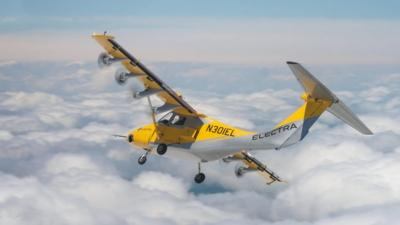Tue, Jun 04, 2024
Aircraft Took Off In Less Than 170 Ft And Landed In Under 114 Ft Ground Roll
Electra has successfully achieved the first high-performance ultra-short flight operations of its piloted blown-lift hybrid-electric short takeoff and landing(eSTOL) demonstrator aircraft (EL-2 Goldfinch).

“Today’s milestone is an incredible achievement as we’ve proven that our eSTOL aircraft has the capability to do what we said it could do – operate from spaces shorter than 300 feet,” said JP Stewart, Electra Vice President and General Manager. “The aircraft handling at low-speeds has been exceptional and is matching our analysis well, building confidence in the predicted capability of the 9-passenger product design. We’ll continue to develop our technologies, including the “thrust-by-wire” flight control system to allow us to fly even slower on approach and further improve the STOL takeoff and landing performance in the ongoing test campaign.”
The test flights, piloted by Cody Allee, took place through April and May 2024 at the Manassas Regional Airport and Warrenton-Fauquier Airport in Virginia. The longest flight lasted 1 hour 43 minutes. During the campaign, the aircraft took off in less than 170 ft and landed in under 114 ft ground roll, the aircraft reached an altitude of 6,500 feet, and it flew as slowly as 25 kts on takeoff and landing.

Data and insights gained from the flight test program will inform the design of Electra’s 9-passenger commercial eSTOL aircraft, with entry into commercial service under FAA Part 23 regulations targeted for 2028.
Electra’s blown-lift design uses eight electric motors to significantly increase wing lift, allowing the eSTOL aircraft to take off and land in just 1/10th of the space needed by conventional aircraft. This enables access to locations that today only helicopters can reach. Quiet electric motors dramatically reduce noise and emissions for community-friendly operations. Hybrid-electric power provides long-range capability without the need for ground-based charging stations.
More News
Its Offerings Are Lighter, Cleaner, and Now Pushing Past 1,000nm on SAF Jet Fuel DeltaHawk’s diesel-powered aircraft lineup has seen incredible upgrades over the last few yea>[...]
The Airplane Experienced A Total Loss Of Engine Power On December 3, 2025, about 1600 central standard time, a Mooney Aircraft Corp. M20K, N57229, was substantially damaged when it>[...]
Make Sure You NEVER Miss A New Story From Aero-News Network Do you ever feel like you never see posts from a certain person or page on Facebook or Instagram? Here’s how you c>[...]
Aero Linx: European Society of Aerospace Medicine (ESAM) As a pan-European, independent forum, it works to promote the safety and health of all persons involved in aviation and spa>[...]
“We are excited to see Wisk achieve this milestone, and I’m so proud of the team that made it possible. The team at Wisk has built advanced technologies across flight c>[...]
 Aero-TV: DeltaHawks Diesel Power Steps Into the Spotlight
Aero-TV: DeltaHawks Diesel Power Steps Into the Spotlight NTSB Prelim: Mooney Aircraft Corp. M20K
NTSB Prelim: Mooney Aircraft Corp. M20K ANN FAQ: Turn On Post Notifications
ANN FAQ: Turn On Post Notifications ANN's Daily Aero-Linx (12.20.25)
ANN's Daily Aero-Linx (12.20.25) Aero-News: Quote of the Day (12.20.25)
Aero-News: Quote of the Day (12.20.25)




